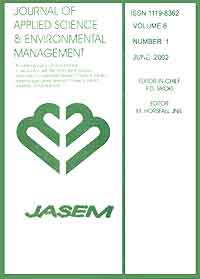
|
Journal of Applied Sciences and Environmental Management
World Bank assisted National Agricultural Research Project (NARP) - University of Port Harcourt
ISSN: 1119-8362
Vol. 20, No. 4, 2016, pp. 1081-1086
|
 Bioline Code: ja16115
Bioline Code: ja16115
Full paper language: English
Document type: Research Article
Document available free of charge
|
|
|
Journal of Applied Sciences and Environmental Management, Vol. 20, No. 4, 2016, pp. 1081-1086
| en |
Evaluation of Serum Anion gap in the three trimesters of Pregnancy in a Christian Religious Hospital in Benin City, Nigeria
OMOROGIUWA, A. & OZOR, M.O.
Abstract
This study is aimed at determining anion gap in the three trimesters of pregnancy. The study involved
a total of 80 volunteers from the St. Philomena Catholic hospital, Benin City. The volunteers comprised 20 nonpregnant
control, and 20 pregnant women in each of the three trimesters of pregnancy. Ethical approval was obtained
from the Ethics and Collaboration committee of the hospital. Informed consents were also obtained from the
participants. With strict aseptic method blood samples were drawn from the ante cubital vein into a lithium heparin
bottle for electrolyte analysis using standard laboratory methods. Anion gap was subsequently calculated using the
formula; ([Na+] + [K+]) − ([Cl-] + [HCO3−]). Results were compared using the student’s t-test and p < 0.05 were
considered statistically significant. The anion gap for the first trimester of pregnancy (11.01 ± 0.13 mmol/L) was
significantly lower (p<0.05) than that of the control group (14.90 ± 0.43 mmol/L). The anion gaps for the second (14.78
± 0.07 mmol/L) and third trimesters of pregnancy (14.90 ± 0.11 mmol/L) were essentially the same as that of the control
subjects. The results may have been due to the variation in the gastrointestinal symptoms associated with the first
trimester of pregnancy. However, the study indicates that pregnant women in their first trimester are more prone to
abnormal serum anion gap which is a function of blood electrolyte concentration. This finding should be reflected by
antenatal care givers and antenatal care policy makers to forestall untoward effect of abnormal serum anion gap.
Keywords
Anion Gap; Electrolyte; Trimester; Pregnancy
|
| |
© Copyright 2016 - Journal of Applied Sciences and Environmental Management
|
|
